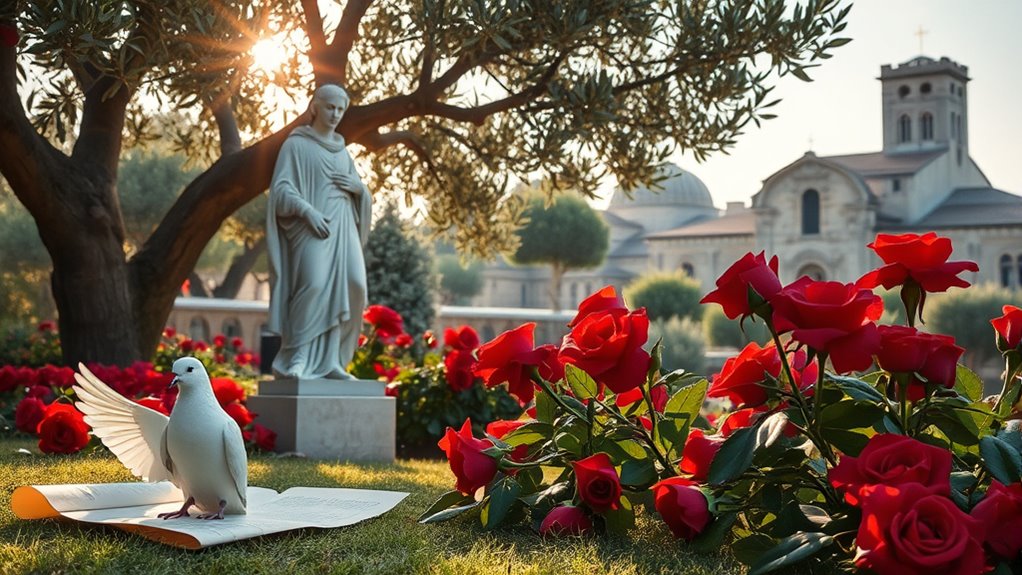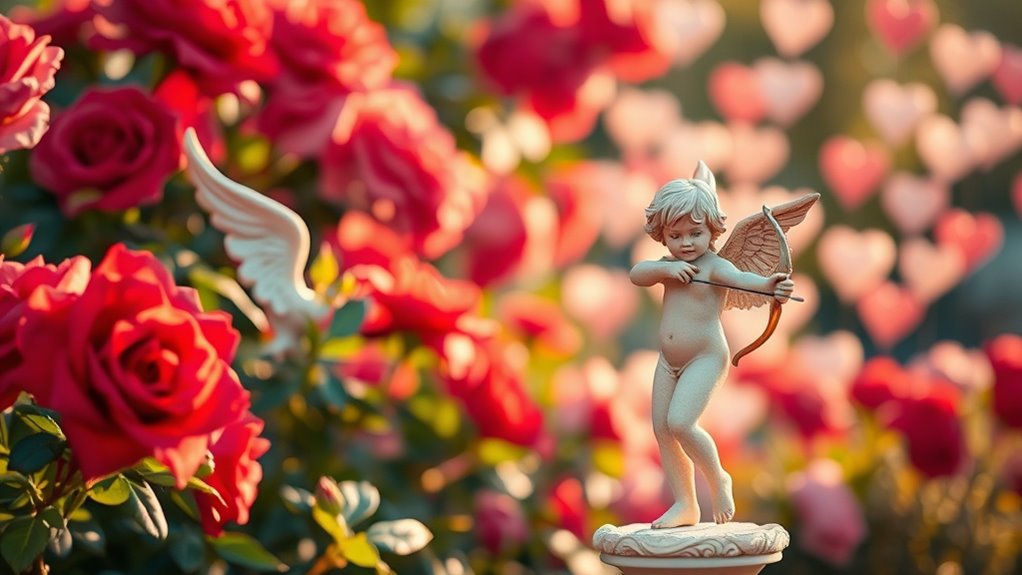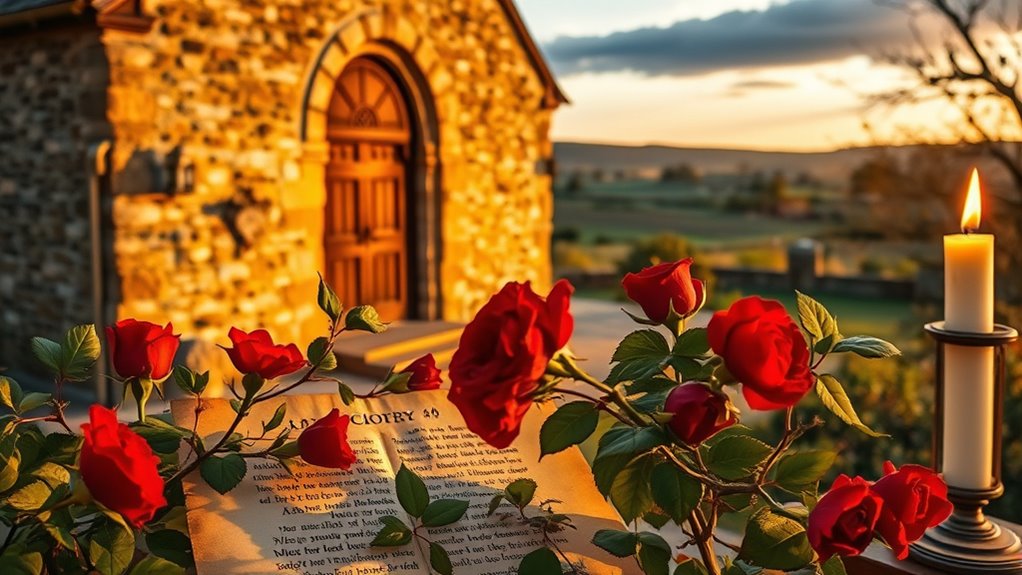Saint Valentine was a 3rd-century martyr who secretly married Christian couples, defying Emperor Claudius II's ban on soldier marriages. Executed on February 14, 269 AD, his legacy celebrates love and commitment. Over the centuries, Valentine's Day evolved from a Christian feast into a romantic holiday, influenced by ancient festivals like Lupercalia. Today, it's a day for expressing affection with cards and gifts. Curious about how these customs developed? There's so much more to discover!
Key Takeaways
- St. Valentine was a 3rd-century martyr who secretly married Christian couples, defying Emperor Claudius II's ban on soldier marriages.
- Executed on February 14, 269 AD, his legacy symbolizes love and commitment, celebrated through the establishment of St. Valentine's Day.
- The holiday evolved from a Christian feast honoring St. Valentine, originally linked to the pagan festival Lupercalia celebrating fertility in mid-February.
- Geoffrey Chaucer's 14th-century writings associated February 14 with romantic love, transforming the day into a celebration of courtship.
- Valentine's Day is now celebrated globally, featuring diverse customs, such as exchanging gifts, cards, and messages of love.
The Legend of St. Valentine

As you explore the origins of Valentine's Day, you'll discover the fascinating legend of St. Valentine. This 3rd-century martyr is primarily known for secretly marrying Christian couples, defying Emperor Claudius II's orders against marriages for soldiers. His belief in love and commitment ultimately led to his execution on February 14, 269 AD. Interestingly, his story has inspired many, much like young tennis prodigies showcasing exceptional skills at a young age, emphasizing the importance of passion and dedication.
The legend also tells of Valentine writing a note to the jailer's daughter, signing it "from your Valentine," which inspired our tradition of sending heartfelt greetings. Balancing career and personal life is essential for relationship health, reminding us that love and commitment require attention and dedication.
Today, relics of Saint Valentine are displayed in places like the Church and Catacombs of San Valentino in Rome and the Whitefriar Street Carmelite Church in Dublin, reminding us of his enduring legacy and the true spirit of love celebrated on this special day.
The Evolution of Valentine's Day

As you explore the evolution of Valentine's Day, you'll see how its celebrations and customs have transformed over centuries. From early Christian traditions to romantic literature, the holiday has taken on new meanings. Today, modern practices reflect both personal gestures and commercial influences, making it a globally recognized occasion. Many people now seek out curated messages & wishes to express their feelings in unique and heartfelt ways. This evolution mirrors the sentiment of purpose-driven quotes, reminding us of the deeper connections we seek in our relationships.
Historical Celebrations and Customs
Valentine's Day has transformed considerably since its origins as a Christian feast day honoring Saint Valentine, who was martyred for defying Emperor Claudius II. Over the centuries, the holiday evolved from early Christian customs of exchanging handmade tokens to the mass production of valentines in the 19th century. Today, many people utilize personalized message generators and digital cards to enhance their celebrations, showcasing the holiday's adaptation to modern practices. The use of natural materials in decorations can also create a warm and inviting atmosphere during Valentine's celebrations.
| Era | Customs |
|---|---|
| Early Christian | Exchanging handmade cards and tokens |
| 14th Century | Geoffrey Chaucer's poem linked romance |
| 19th Century | Rise of mass production of valentines |
| Modern Day | Diverse global celebrations and spending growth |
Today, people celebrate with romantic dinners and extravagant gifts, reflecting the rich history of Valentine's Day and its significant cultural impact.
Romantic Associations and Literature
While the celebration of love has evolved over the centuries, romantic associations tied to Valentine's Day have deep literary roots. The connection between February 14 and romantic love began with Geoffrey Chaucer's poem "Parliament of Fowls," where birds choose their mates. This date also links back to Saint Valentine's love notes, enriching the tradition of heartfelt messages. Attention to detail in these notes reflects the personal touch that makes each expression of love unique.
Here are some key developments:
- By the 18th century, couples exchanged handmade cards and flowers.
- The Victorian-era cards reflected courtship attitudes with elaborate designs.
- Chocolates became a popular gift, especially after Cadbury's heart-shaped boxes in 1868.
- The commercialization of Valentine's Day surged, leading to mass-produced cards and gifts.
- Additionally, cute acne patches have become a playful way to boost confidence during this romantic season, allowing individuals to feel their best while celebrating love.
These elements shaped how we celebrate love today.
Modern Practices and Traditions
Though many might think of Valentine's Day as solely a celebration of romantic love, its practices and traditions have evolved considerably over time. Originally honoring Saint Valentine, this day now embraces a broader spectrum of affection.
In the 18th century, people began exchanging handwritten notes and tokens of affection, leading to the first commercial valentines in the mid-1800s. By the late 19th century, the commercialization of Valentine's Day soared with Cadbury's heart-shaped chocolate boxes, much like the rise of commercialization of holidays seen with other festive occasions.
Today, modern practices include exchanging greeting cards, chocolates, and flowers, with around 190 million valentines sent each year in the U.S. This holiday has also inspired unique traditions globally, such as Día de los Enamorados in Latin America and White Day in Japan, celebrating love in diverse ways. Embracing positive thinking can enhance the joy of celebrating relationships on this special day.
Connections to Ancient Festivals

As you explore the connections between Valentine's Day and ancient festivals, you'll notice how Lupercalia's traditions shaped modern celebrations. The Christianization of pagan practices is evident in how rituals of love and fertility evolved over time. You'll also see how romantic associations began to emerge, setting the stage for the holiday we recognize today. This evolution reflects a broader trend of integrating natural materials into our celebrations, echoing the emphasis seen in modern farmhouse decor. Additionally, the celebration of love has been influenced by cultural influences that enrich the way we express affection today.
Lupercalia Festival Traditions
Lupercalia, celebrated on February 15, reveals fascinating traditions that highlight the ancient Romans' connection to fertility and purification. This festival featured unique practices that shaped later customs, including:
- Sacrificial Rites: Priests known as Luperci sacrificed goats, using their hides to whip women, believing it enhanced fertility.
- Lottery System: Young men drew names of women, pairing them for the festival, often leading to temporary relationships or marriages.
- Feasting and Merriment: Participants engaged in lively revelries, celebrating life and love. These celebrations may have contributed to the establishment of various biodiversity hotspots as communities gathered in nature to honor love.
- Conflict with Christian Values: As Christianity spread, these traditions conflicted with new beliefs, prompting changes.
Some scholars suggest that Pope Gelasius aimed to Christianize Lupercalia by establishing St. Valentine's Day, redirecting its focus toward honoring love and marriage. Additionally, the festival's emphasis on fertility rituals may have influenced the way modern societies celebrate love and connection.
Christianization of Pagan Practices
The Christianization of pagan practices like Lupercalia reflects the church's strategy to reshape cultural traditions.
In mid-February, Lupercalia celebrated fertility through rituals, but the church established St. Valentine's Day on February 14th to honor Saint Valentine, a martyr. This adaptation recontextualized Lupercalia's matchmaking practices under the banner of Christian love. As a result, the celebration began to emphasize love and compassion in its observance.
By the 14th century, the association of February 14 with romantic love emerged, influenced by Geoffrey Chaucer's writings that linked the day to birds' mating season.
As the decline of Lupercalia coincided with the rise of courtly love, St. Valentine's Day gained new cultural significance, transforming from a pagan fertility festival into a celebration of love and marriage, reflecting the church's broader efforts to integrate pagan customs. Nighttime meditation has also become a popular practice for couples seeking to enhance their emotional connection on this day.
Romantic Associations Emerge
While many might think of Valentine's Day as a modern celebration of romance, its roots trace back to ancient festivals that honored love and fertility. This connection deepened with the Christianization of Lupercalia, which celebrated spring and fertility. Interestingly, studies suggest a correlation between astrological signs and perceived beauty, which may enhance the romantic aspect of the holiday.
By the 14th century, Geoffrey Chaucer's poem "Parliament of Fowls" further linked February 14 to romantic love, marking a shift toward courtly love practices. The evolution of Valentine's Day involved:
- Merging Christian and pagan traditions.
- Celebrating fertility and springtime.
- Emphasizing romantic pairings.
- Inspiring love letters and poetry.
Additionally, the importance of communal celebrations and shared meals is reminiscent of how food plays a vital role in social gatherings and celebrations across different cultures. These elements contributed to the enduring legacy of Valentine's Day as a cherished day dedicated to love, allowing you to express your feelings in this special month.
The Role of Cupid in Valentine's Day

Cupid plays a pivotal role in the celebration of Valentine's Day, symbolizing the essence of love and desire. Originating from Greek mythology as Eros, he's depicted as a winged cherub, often with his bow and arrows, striking romantic connections in the hearts of mortals.
This playful imagery, which emerged during the Hellenistic period, contrasts with earlier representations of a handsome youth. His association with Valentine's Day was solidified in the 14th century through the works of Geoffrey Chaucer, who linked him to romantic love.
Today, Cupid's presence is central to the holiday, appearing in various forms on greeting cards, decorations, and gifts, encapsulating the celebration's focus on love and affection while reflecting its rich origins. Interestingly, the modern-day celebration of love is often reflected in celebrity relationships, such as Jennifer Aniston and Brad Pitt maintaining a friendly post-divorce connection.
Celebratory Traditions Around the World

Celebrating Valentine's Day varies widely across the globe, showcasing unique customs and traditions that reflect different cultural perspectives on love.
Valentine's Day celebrations around the world reveal rich traditions and diverse expressions of love.
Here are some notable ways Valentine's is celebrated:
- Japan: On February 14, women give chocolates, while men return the favor on White Day, March 14. This tradition aligns with current trends in gifting, emphasizing the importance of thoughtful presents.
- South Korea: Singles gather on April 14 for Black Day, enjoying jajangmyeon to commemorate their status.
- Italy: Tourists visit Verona to leave love letters at Juliet's balcony, inspired by the tale of Romeo and Juliet.
- Latin America: Known as Día de los Enamorados or Día del Amor y la Amistad, this day emphasizes love for friends and partners alike.
These cultural traditions highlight the diverse meanings of love tied to Saint Valentine's legacy. Additionally, the significance of financial stability during celebrations can enhance the experience of sharing love through thoughtful gifts and experiences.
Unique Customs and Surprising Facts

As you explore the diverse customs surrounding Valentine's Day, you'll find fascinating traditions that reveal how people express their affection in unique ways.
In Japan, women give chocolates to men on February 14, while men reciprocate with gifts on White Day, celebrated a month later.
South Korea celebrates Black Day on April 14, where singles enjoy jajangmyeon to embrace their status.
In Italy, you can visit Verona, where love letters are left at Juliet's balcony, hoping for romantic luck.
Guatemalans celebrate Día del Cariño on February 14, expressing appreciation for friends and loved ones, not just romantic partners.
Even in Saudi Arabia, where Valentine's Day is banned, a black market for gifts thrives, proving the holiday's enduring appeal. Additionally, the celebration of love can lead to increased property value through modern, efficient heating solutions, highlighting the benefits of choosing the best heat pump.
Frequently Asked Questions
Who Was Saint Valentine and Why Do We Celebrate Valentine's Day?
Saint Valentine was a priest in ancient Rome, known for performing secret Christian marriages, defying Emperor Claudius II.
You celebrate Valentine's Day on February 14 to honor his legacy of love and commitment.
Over time, this day evolved from recognizing a martyr to a celebration of romantic affection.
It's a chance for you to express your feelings through cards, gifts, and gestures, making it a significant occasion in modern culture.
What Is the Origin or Origins of Valentine's Day?
Valentine's Day has roots in ancient Rome, where it evolved from the Lupercalia festival, celebrating fertility.
In the 5th century, Pope Gelasius I replaced it with a feast to honor Saint Valentine, a martyr known for defying marriage bans.
Over time, the day became associated with romantic love, especially after Geoffrey Chaucer's poem in 1382 likened it to birds choosing their mates.
Today, it's a celebration of love and affection.
Why Do We Celebrate Valentine?
You celebrate Valentine's Day because it's the most romantic day of the year, a time when love flows like an endless river!
This special occasion gives you a chance to express your feelings, whether through heartfelt gifts or sweet gestures.
It's a day to honor relationships, cherish connections, and create lasting memories.
You might exchange cards, enjoy a cozy dinner, or simply share your affection, making it a delightful celebration of love in all its forms.
What Is the Origin of the Valentine's Day Heart?
The heart shape you see on Valentine's Day has deep roots in history. It symbolizes love and affection, first emerging in ancient depictions of the human heart as the center of emotion.
Conclusion
As you unwrap the layers of Valentine's Day, you discover a tapestry woven with tales of love, legend, and laughter. From the enigmatic St. Valentine to Cupid's mischievous arrows, this day blooms with history and heart. Whether you're exchanging sweet notes or sharing a romantic dinner, remember that love transcends time and tradition. So, embrace the spirit of connection, let your heart dance, and celebrate the beautiful symphony of affection that binds us all.










